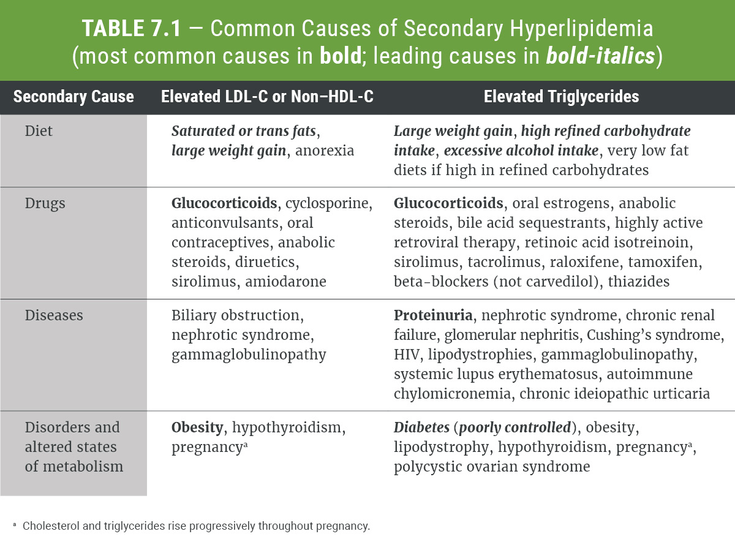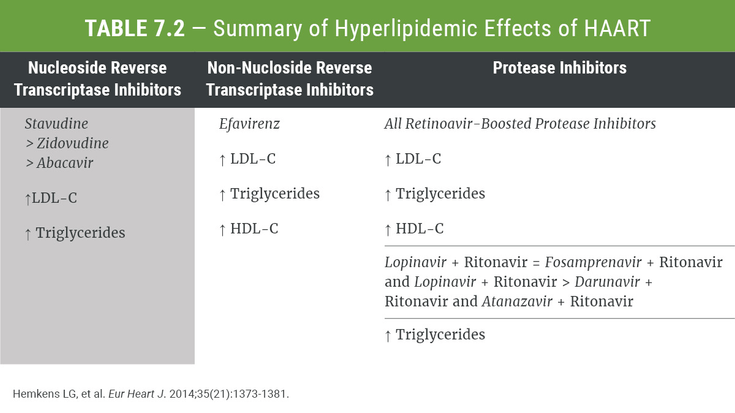Secondary Hyperlipidemia
Introduction
Patients with low-density lipoprotein cholesterol (LDL-C) ≥190 mg/dL, non– high-density lipoprotein cholesterol (HDL-C) ≥220 mg/dL, or triglycerides ≥500 mg/dL may have underlying or acquired conditions exacerbating a genetic predisposition to a hyperlipidemic state. If treatable or reversible, these conditions could influence the decision to initiate or modify treatment.
Numerous causes of “secondary” hyperlipidemia have been identified (Table 7-1). Nearly one third of patients referred to a specialty lipid clinic may have a secondary condition contributing to their dyslipidemia. However, these patients often remain at increased ASCVD risk due to age and risk factor levels even if the secondary cause of hyperlipidemia is resolved.
Clinical Highlight I
- LDL-C ≥190 mg/dL, non–HDL-C ≥220 mg/dL, or triglycerides ≥220 mg/dL: evaluate secondary causes.
- Initial tests if no clear cause on exam: HbA1C, TSH, alkaline phosphatase, bilirubin, ALT,…
To continue reading
Log in or register to continue reading. It's free!
OR
By signing up to create an account, I accept Healio's Terms of Use and Privacy Policy.
Introduction
Patients with low-density lipoprotein cholesterol (LDL-C) ≥190 mg/dL, non– high-density lipoprotein cholesterol (HDL-C) ≥220 mg/dL, or triglycerides ≥500 mg/dL may have underlying or acquired conditions exacerbating a genetic predisposition to a hyperlipidemic state. If treatable or reversible, these conditions could influence the decision to initiate or modify treatment.
Numerous causes of “secondary” hyperlipidemia have been identified (Table 7-1). Nearly one third of patients referred to a specialty lipid clinic may have a secondary condition contributing to their dyslipidemia. However, these patients often remain at increased ASCVD risk due to age and risk factor levels even if the secondary cause of hyperlipidemia is resolved.
Clinical Highlight I
- LDL-C ≥190 mg/dL, non–HDL-C ≥220 mg/dL, or triglycerides ≥220 mg/dL: evaluate secondary causes.
- Initial tests if no clear cause on exam: HbA1C, TSH, alkaline phosphatase, bilirubin, ALT, creatinine, urinary albumin at a minimum; consider total protein and in women of child-bearing age, a βhCG.
Common Causes of Secondary Hyperlipidemia
LDL-C and Non–HDL-C
In general practice, the most common causes of secondary causes of LDL-C elevations include excess dietary intake of saturated fat and recent large weight gain (Table 7-1). These conditions also contribute to non–HDL-C elevations, as do the insulin resistant states of obesity, diabetes and glucocorticoid intake. Moderate to severe hypothyroidism (TSH >10 µIU/mL) and biliary obstruction are not uncommon contributors.
Triglycerides
The most common secondary causes of triglyceride elevations and triglycerides ≥500 mg/dL are undiagnosed or poorly controlled diabetes, high refined carbohydrate intake (which includes the 2-carbon fragments of alcohol) and recent large weight gain exacerbating insulin resistance. Glucocorticoids commonly worsen triglyceride levels, as do estrogen and anabolic steroids. Bile acid sequestrants can markedly exacerbate moderate hypertriglyceridemia and are contraindicated if triglycerides are ≥300 mg/dL.
Evaluation for Secondary Causes
Secondary causes of hyperlipidemia should be evaluated in patients with:
- Newly identified LDL-C ≥190 mg/dL or non–HDL-C ≥220 mg/dL
- Newly identified triglycerides ≥500 mg/dL
- Worsening LDL-C, non–HDL-C, or triglyceride levels despite adherences to lifestyle and drug therapy.
Initial laboratory tests should include:
- Fasting glucose or hemoglobin A1C (HbA1C)
- Thyroid-stimulating hormone (TSH)
- Alkaline phosphatase, bilirubin and alanine aminotransferase (ALT)
- Creatinine/glomerular filtration rate (GFR)
- Urinary albumin.
Additional tests include:
- Total protein
- Women of childbearing age: beta human chorionic gonadotropin (βhCG).
Secondary Hyperlipidemia: Special Populations HIV
HIV infection itself may increase triglycerides due to impaired lipolysis and increased hepatic lipogenesis. Hypertriglyceridemia commonly occurs in patients receiving highly active antiretroviral therapy (HAART) for HIV suppression, while hypercholesterolemia occurs somewhat less commonly. Redistribution of adipose tissue and ectopic fat disposition occurs in about half of patients receiving long-term HAART. Lipodystrophy can manifest as both lipoatrophy and hypertrophy (e.g., the buffalo hump). Lipohypertrophy and visceral fat deposits are commonly associated with hypertriglyceridemia, reduced insulin sensitivity and diabetes.
The extent of lipid changes varies among antiretroviral regimens (Table 7-2). First-generation protease inhibitors (PI) (e.g., indinavir, lopinavir) are more likely to cause greater increases in total cholesterol, LDL-C and triglycerides than second generation PIs (e.g., atazanavir and darunavir). Non-nucleoside reverse transcriptase inhibitors (NNRTI) (e.g., efavirenz) increase total cholesterol and LDL-C more than second-generation PIs. Improvements in triglyceride and LDL-C levels are observed when switching from lopinavir + ritonavir to atanazavir + ritonavir or atanazavir (please refer to the most recent HIV management guideline for updates) (see Special Clinical Populations).
HIV-infected patients are at increased ASCVD risk, which may be further increased due to their HAART regimen.
Statins are the first choice for reducing ASCVD risk in these patients (see Special Clinical Populations). Lovastatin and simvastatin should be avoided due to high potential for antiretroviral drug interactions due to CYP3A4 inhibition.
If lifestyle changes and maximally tolerated intensity of statin are not effective in reducing triglycerides to <500 mg/dL, fibrates and omega-3 fatty acids represent additional drug options. Gemfibrozil has more drug interactions than fenofibrate. Omega 3 fatty acids (3-3.5 g/d DHA+EPA) have no potential for drug interaction but may have lower adherence at the effective dose and more difficult to tolerate.
Figure 7-1 shows the drug interactions between lipid-lowering drugs and antiretroviral drugs. For the most up-to-date list of lipid-lowering drug antiretroviral interactions, access: https://www.hiv-druginteractions.org/checker.

Immunosuppressed Patients
Following organ transplantation, most patients develop moderate-severe hypertriglyceridemia and occasionally hypercholesterolemia. Hyperlipidemia also occurs in patients with autoimmune diseases.
Immunosuppressant drugs are the leading cause of hyperlipidemia, with contributions from genetics, diabetes and renal disease. Calcineurin inhibitors (cyclosporine, tacrolimus), mammalian target of rapamycin (mTOR) inhibitors (sirolimus, everolimus, temsirolimus) and glucocorticoids are the most common immunosuppressive drug cause of hyperlipidemia.
The risk of complications from severe hypertriglyceridemia needs to be carefully weighed against the potential loss of immunosuppression from altering the immunosuppressant drug regimen. Triglycerides ≥500 mg/dL should be managed with lifestyle changes and omega-3 fatty acids 3-3.5 g/day are preferred to fenofibrate, which may significantly increase the risk of myopathy when used in combination with statins and cyclosporine (see Statins and Managing Hypertriglyceridemia).
LDL-C lowering to reduce ASCVD risk can be achieved with lifestyle, a carefully selected statin and ezetimibe. Statins have significant interactions with a number of immunosuppressive agents, including cyclosporine and tacrolimus (see Statins). Hyperlipidemia refractory to lipid drugs may respond to changes in immunosuppression. Changes in immunosuppression should only be undertaken by a transplant specialist.
References
- Robinson JG. Clinical Lipid Management, 2nd ed. Professional Communications Inc. 2023
- Drug Interaction Charts. The University of Liverpool Web site. https://www.hiv-druginteractions.org/checker. Accessed January 10, 2023.





